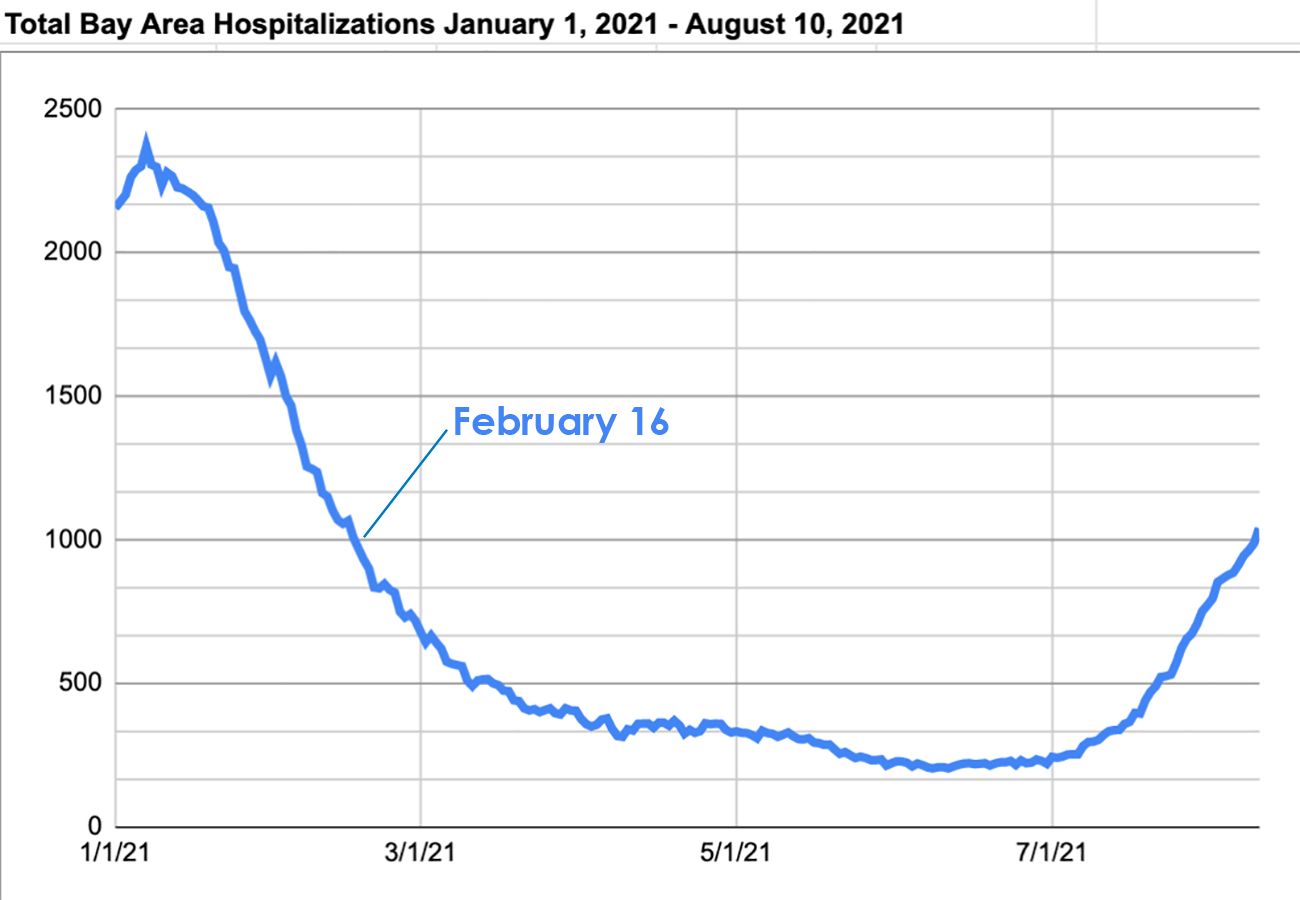Hospitalizations from COVID-19 continue climbing across California, and in the Bay Area, the number of hospitalized patients with serious cases rose above 1,000 for the first time since mid-February.
The Delta surge likely hasn't peaked here yet, and as with previous surges, we know that the hospitalization numbers tend to lag behind rises in cases by several weeks. As of Tuesday, there were 1,040 confirmed and suspected COVID patients in Bay Area hospitals, up from 987 on Monday, according to state data. This marks the first time that hospitalizations have risen above the 1,000 mark since February 16, when the winter surge was waning and there were 1,008 people in Bay Area hospitals.

Due to high rates of vaccination, the number of people dying from COVID infections appears to be less, but the actual mortality rate we're seeing from the Delta variant in the region now isn't yet clear. Since July 2, 112 people have died from COVID in the Bay Area; statewide, 1,030 have died in that same span.
Out of the 1,040 hospitalized at present in the Bay Area, 240 are in ICU beds, or 23%. It's not clear how many of those in hospitals were fully vaccinated, though doctors have been noting anecdotally that the majority are unvaccinated, and those who are fully vaccinated tend to be elderly and have underlying conditions that lead to more serious cases.
The number of hospitalized has been steadily rising across California since early July, a couple of weeks after the June 15th date when bars, restaurants, gyms, and movie theaters all were able to reopen fully and drop mask mandates. SFist noted on July 2 that hospitalizations were already ticking up, and by late July it was clear that the Delta variant had changed the calculus around reopening — leading to the CDC issuing a nationwide recommendation on July 27 that masks stay on indoors even for the vaccinated.
Breakthrough infections remain possible among the vaccinated — and with vaccinated infecting vaccinated — moreso with the Delta variant, though the exact numbers remain obscure. As the New York Times reports today, the CDC isn't fully tracking breakthrough infections and their outcomes, so exact numbers will remain hard to come by — also, with the wide availability of at-home tests and the likelihood that these infections are mild, a large portion of them are likely going unrecorded.
"A modest percentage of people who are fully vaccinated will still get COVID-19 if they are exposed to the virus that causes it," said CDC Director Dr. Rochelle Walensky, in an email to the Times.
Anecdotally around San Francisco, that has translated to many people working in the service industry and/or traveling this summer falling ill — or testing positive and having one or more symptoms — in recent weeks. And this has led to a coalition of Bay Area health officers issuing a mandate for masks indoors as of August 2, with compliance being hit or miss and dependent on businesses to police the policy.
"I think that if we started to test people just randomly on the street, we would find a lot more people who test positive," says Dr. Abraar Karan, an infectious diseases fellow at Stanford, speaking to the Times.
What has held true, even with the more infectious variant, is that the vaccines are working to prevent serious illness and death. And California's comparatively high rate of vaccination compared to Florida has been born out in the hospitalization numbers there versus here during this surge.
California doing much better with Delta variant than Florida, Texas. Here’s why https://t.co/RVrYb6pB1g @LukeMMoney @mollyhf pic.twitter.com/OBJUbnGrcr
— Ron Lin (@ronlin) August 11, 2021
But with as much virus as seems to be circulating now across the Bay Area, it's anyone's guess when this surge will peak and began to wane, sending fewer people to the hospital. As the Chronicle reported last week, the best guess seems to be early to mid September.
San Francisco's seven-day rolling average of daily new cases ticked slightly down last week — hitting 263 on August 3, down from 272 a day earlier. But it is far from clear if the city has hit its peak.

Previously: Put Your Masks Back On Everywhere Indoors, Bay Area — Health Officers Seek To Tamp Down Delta Surge

